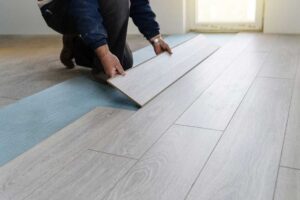
When planning your wood flooring project, choosing the right underlayment is crucial—not only for the performance and durability of your floors but also for the environmental impact of your renovation. With growing awareness around sustainability, many homeowners and professionals are now seeking eco-friendly options that combine function with a lower carbon footprint. In this blog, we’ll explore some of the best eco-friendly underlayment choices for wood flooring projects and provide guidance on how to make a smart, green choice.
The Importance of Underlayment for Wood Floors
Before diving into eco-friendly options, it’s essential to understand why underlayment matters. An underlayment for wood floors acts as a cushion between your subfloor and the hardwood planks, providing several benefits:
- Moisture Protection: Helps prevent moisture from seeping up from the subfloor, which can warp or damage wood.
- Sound Reduction: Absorbs sound, making floors quieter underfoot.
- Thermal Insulation: Can improve energy efficiency by providing an insulating layer.
- Smoothness: Helps correct minor imperfections in the subfloor for a more stable installation.
Choosing the right underlayment can significantly impact the longevity and performance of your wood floors. Let’s now look at some sustainable options that don’t compromise on quality.
Top Eco-Friendly Underlayment Materials
-
Cork Underlayment
Cork is a renewable material harvested from the bark of the cork oak tree without harming the tree itself. This makes it a truly sustainable option for an underlayment for wood floors. Cork offers excellent sound insulation, natural antimicrobial properties, and thermal resistance.
Benefits of Cork Underlayment:
- Renewable and biodegradable.
- Hypoallergenic and resistant to mold and mildew.
- Naturally cushioned, providing comfort underfoot.
- Excellent sound absorption.
Considerations:
- Cork is best for areas without excessive moisture exposure, as it can absorb water if not sealed properly.
-
Recycled Felt Underlayment
Recycled felt, made from post-industrial or post-consumer textiles, is an increasingly popular eco-friendly choice. It provides strong acoustic performance and cushioning for wood floors.
Benefits of Recycled Felt:
- Diverts waste from landfills.
- Provides thermal and sound insulation.
- Durable and long-lasting.
Considerations:
- Not always fully waterproof, so pair it with a vapor barrier if moisture is a concern.
-
Rubber Underlayment
Recycled rubber underlayment, made from materials like used tires, is a robust and environmentally friendly option. It excels at sound absorption and impact resistance, making it ideal for high-traffic areas.
Benefits of Rubber Underlayment:
- Extremely durable and moisture resistant.
- Excellent for sound dampening.
- Diverts rubber waste from landfills.
Considerations:
- Heavier than other options, so it may require more effort during installation.
-
Natural Fiber Underlayment
Natural fiber underlayments, such as those made from jute, hemp, or wool, offer biodegradable alternatives with excellent insulation and moisture-wicking properties.
Benefits of Natural Fiber Underlayment:
- Renewable and compostable.
- Excellent moisture management.
- Provides natural thermal and sound insulation.
Considerations:
- Additional moisture barriers may be required depending on the subfloor.
Factors to Consider When Choosing Eco-Friendly Underlayment
Moisture Levels
For areas prone to moisture, such as basements or kitchens, opt for an underlayment that offers moisture resistance or pair it with a vapor barrier. Materials like rubber or properly treated cork are ideal.
Acoustic Performance
If sound insulation is a priority, particularly in multi-level homes or apartments, consider cork, rubber, or felt underlayments. They are excellent at absorbing sound and reducing footstep noise.
Thermal Insulation
For energy efficiency, underlayments with good thermal properties, such as cork, felt, or wool, can help retain heat in your home, reducing energy bills over time.
Environmental Certifications
Look for products certified by organizations like FloorScore, GreenGuard, or Cradle to Cradle, ensuring they meet strict environmental and health standards.
Installation Ease
Some eco-friendly underlayments are easier to install than others. Rolled cork and felt are often DIY-friendly, while heavier materials like rubber may require professional help.
Making an Informed Choice
Selecting the right eco-friendly underlayment for wood floors involves balancing sustainability with performance needs. Here’s a quick decision guide:
| Underlayment Type | Sustainability Score | Moisture Resistance | Acoustic Performance | Comfort | Best For |
| Cork | ★★★★★ | Moderate | High | High | Living rooms, bedrooms |
| Recycled Felt | ★★★★ | Moderate | High | Moderate | Apartments, multi-level homes |
| Rubber | ★★★★ | High | Very High | High | High-traffic areas, basements |
| Natural Fiber | ★★★★ | Moderate | Moderate | Moderate | Bedrooms, low-moisture areas |
Conclusion
Choosing an eco-friendly underlayment for wood floors is a smart way to enhance the performance of your flooring while reducing your environmental footprint. Whether you prefer cork for its renewability, recycled felt for its waste-reducing properties, or rubber for its durability, there are sustainable options to match your priorities. As you plan your wood flooring project, remember that the right underlayment is a critical foundation—literally and figuratively—for a beautiful, long-lasting, and environmentally responsible home.
Ready to start your flooring journey? Explore eco-friendly underlayment choices and make a positive impact—one plank at a time.
